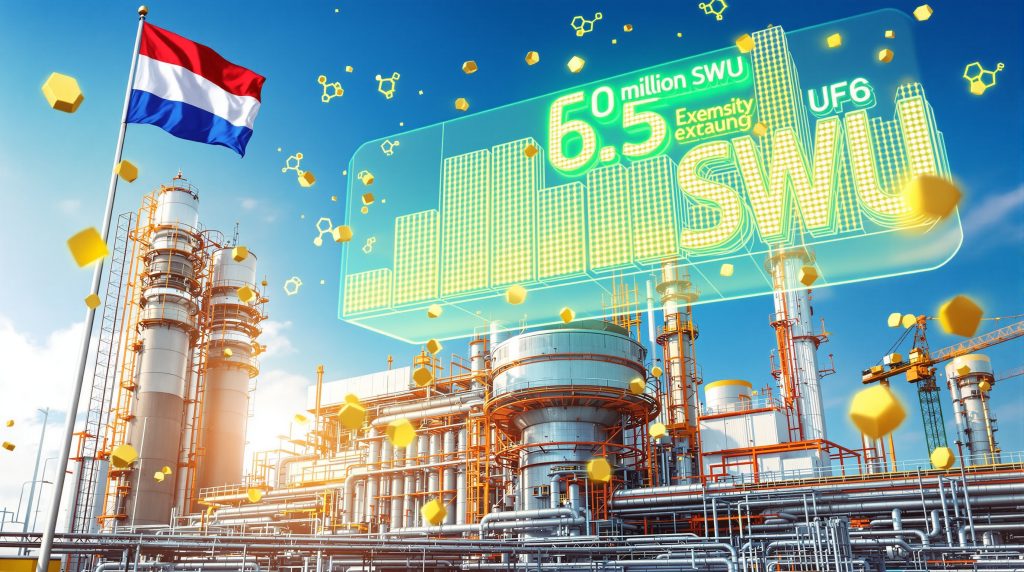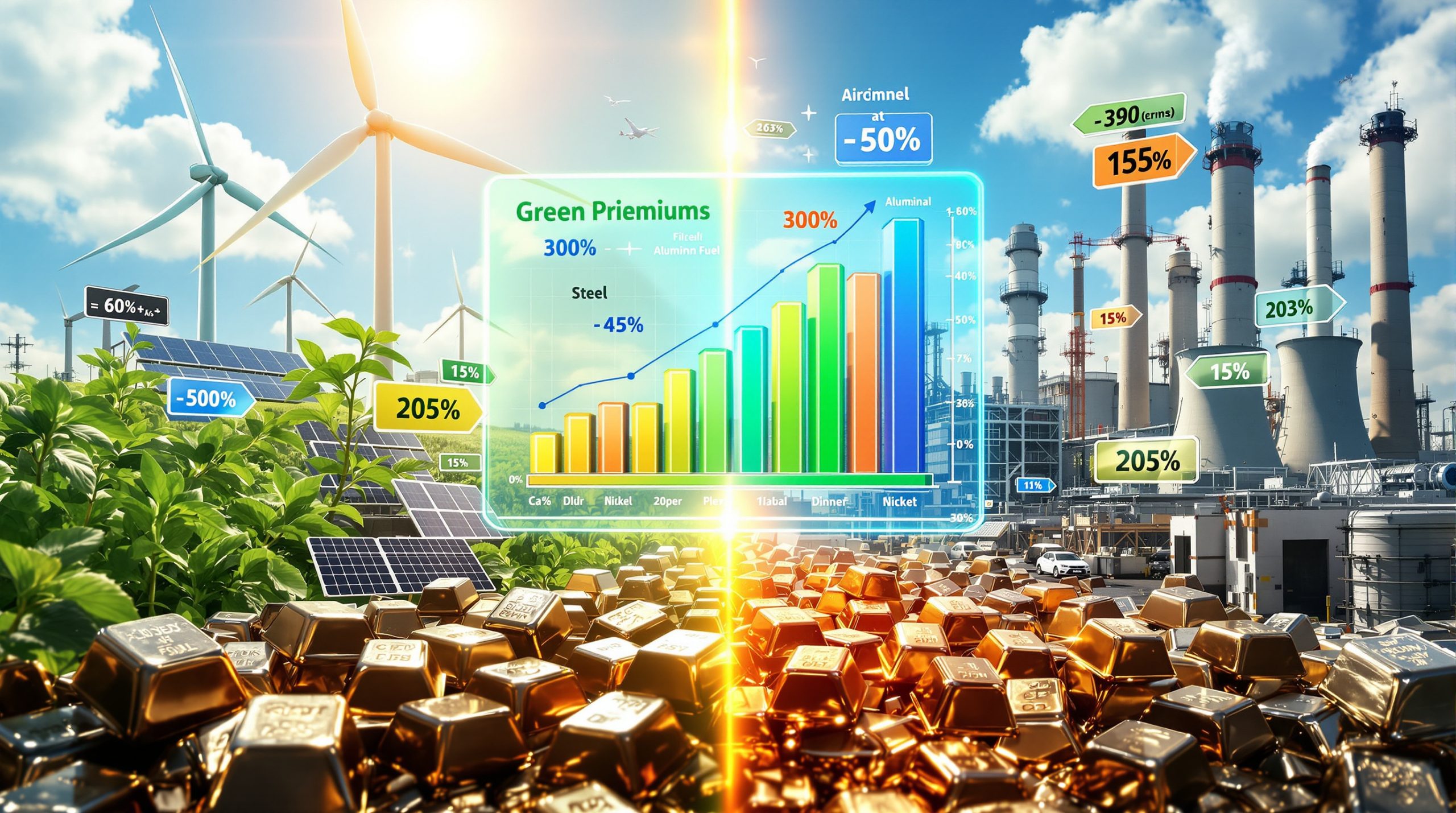Understanding Urenco's Strategic Capacity Doubling Initiative
The uranium enrichment landscape is witnessing an unprecedented transformation as Urenco doubles uranium enrichment expansion Netherlands plans to substantially enhance its Netherlands operations. This strategic expansion represents the most ambitious capacity buildout in the company's global expansion program, positioning the Almelo facility as a cornerstone of Western nuclear fuel security.
Breaking Down the Almelo Facility Enhancement Plan
Urenco's expansion strategy unfolds across two distinct phases, each carefully designed to maximize operational efficiency while meeting growing global demand. The first phase, originally announced in 2023, involves adding 750,000 separative work units (SWU) to the existing infrastructure. This initial enhancement represents approximately a 15% capacity increase from the current 5.0 million SWU baseline.
The timeline progression demonstrates Urenco's commitment to rapid deployment. The first phase targets operational status by 2027, providing utilities with additional enrichment services within the next three years. The second phase extends this expansion through 2030, creating a total capacity addition of 1.5 million SWU across both phases.
Capacity Enhancement Breakdown:
- Phase One: 750,000 SWU addition (2027 target)
- Phase Two: Additional 750,000 SWU (2030 completion)
- Total Expansion: 1.5 million SWU
- Final Capacity: 6.5 million SWU annually
When compared to existing facility output levels, this expansion transforms Almelo into one of Europe's most significant enrichment centers, capable of supporting hundreds of reactor-years of fuel requirements.
Technical Specifications of the New Centrifuge Infrastructure
The expansion necessitates constructing an additional centrifuge hall to accommodate the second phase infrastructure. This new facility will house modern centrifuge technology, representing significant efficiency improvements over legacy systems deployed in earlier decades.
Separative Work Units measure the effort required to enrich uranium, accounting for both the quantity of material processed and the degree of enrichment achieved. Each SWU represents the separation work needed to produce one kilogram of uranium enriched to a specific level from natural uranium feed material.
Modern Centrifuge Advantages:
- Enhanced separation efficiency per unit
- Reduced energy consumption per SWU
- Improved reliability and maintenance intervals
- Greater throughput capacity per centrifuge cascade
- Advanced monitoring and control systems
The integration with existing Almelo operations requires careful coordination to maintain current production levels while constructing and commissioning new capacity. This phased approach minimizes operational disruptions while ensuring continuous fuel supply to contracted customers.
How Does This Expansion Address Current Nuclear Fuel Market Dynamics?
Supply Chain Security Motivations
Western nations have fundamentally reassessed nuclear fuel supply chain vulnerabilities following geopolitical developments since 2022. The European Union's REPowerEU plan specifically targets reducing dependency on Russian nuclear materials, creating substantial demand for alternative enrichment capacity. Furthermore, recent developments such as the US uranium import ban have intensified these security concerns.
Customer contract commitments drive expansion decisions at Urenco, with long-term utility partnerships requiring guaranteed supply security. These contracts typically span 10-20 years, providing the financial foundation necessary for major capital investments in enrichment infrastructure.
Key Market Drivers:
- Supply diversification: Reducing reliance on single-source suppliers
- Strategic stockpiling: Building inventory reserves for supply disruptions
- Contract security: Long-term agreements requiring guaranteed capacity
- Regional stability: Supporting local nuclear industries and employment
Regional employment stability considerations factor prominently in expansion planning. The Almelo facility supports hundreds of specialized technical positions, contributing significantly to the local Dutch economy through high-skilled manufacturing and engineering roles.
Global Enrichment Capacity Context
| Facility Location | Current Capacity | Planned Addition | Timeline |
|---|---|---|---|
| Almelo, Netherlands | 5.0 million SWU | 1.5 million SWU | 2027-2030 |
| Eunice, New Mexico | Expanding | First cascades online | 2025 |
| Gronau, Germany | Operational | Efficiency upgrades | Ongoing |
| Capenhurst, UK | Operational | HALEU capability | Development |
Urenco has committed globally to 2.5 million SWU of new enrichment capacity across its international facilities. The Netherlands expansion represents the largest single contribution to this global commitment, demonstrating the strategic importance of the Almelo site.
The Eunice facility in New Mexico achieved its first operational milestone with two centrifuge cascades now online, supporting North American fuel supply security. Meanwhile, the Gronau plant in Germany undergoes retrofitting with modern centrifuge technology to enhance overall plant capacity through efficiency improvements.
What Are the Broader Implications for European Energy Independence?
REPowerEU Plan Alignment
The European Union's REPowerEU framework establishes ambitious nuclear material diversification goals, targeting reduced dependency on non-EU sources for critical fuel cycle materials. This policy framework creates regulatory support for domestic enrichment capacity investments while establishing clear timelines for supply chain transitions.
Phase-out schedules for Russian-origin enriched uranium vary by member state, but the overall trajectory points toward complete independence by 2030. This timeline aligns perfectly with Urenco doubles uranium enrichment expansion Netherlands completion date, positioning the enhanced Almelo facility as a cornerstone of European fuel security.
Policy Implementation Framework:
- Diversification targets: Reducing single-source dependencies below 20%
- Strategic reserves: Building 18-month fuel inventory buffers
- Cross-border cooperation: Coordinating procurement across EU member states
- Investment incentives: Supporting domestic fuel cycle infrastructure
Cross-border energy security coordination involves sharing enrichment capacity among EU utilities, creating economies of scale while reducing individual country supply risks. This cooperative approach strengthens the overall European nuclear industry's resilience against external supply disruptions. Additionally, comprehensive energy security strategies are being implemented across multiple critical resource sectors.
Economic Impact Assessment
Regional employment generation extends beyond direct facility operations to encompass supporting industries, maintenance contractors, and specialised service providers. The Almelo expansion creates opportunities for nuclear engineers, technicians, security specialists, and administrative staff throughout the project lifecycle.
Critical Investment Insight: The Netherlands expansion represents the largest single enrichment capacity buildout in Urenco's global program, requiring substantial capital investment in advanced centrifuge technology and supporting infrastructure.
Capital investment magnitudes for enrichment facilities typically range from $1,000 to $3,000 per annual SWU of capacity, suggesting the 1.5 million SWU expansion could require $1.5 billion to $4.5 billion in total investment across both phases. However, specific funding details remain proprietary to Urenco's corporate planning processes.
Economic Multiplier Effects:
- Direct employment: Facility operations and maintenance staff
- Indirect employment: Suppliers, contractors, and service providers
- Tax revenues: Corporate and employee income tax contributions
- Export earnings: International enrichment services revenue
- Technology leadership: Advanced manufacturing expertise development
Export potential for European enrichment services extends beyond EU borders, with potential customers in Asia, Africa, and the Americas seeking supply diversification. This global market access enhances the economic returns on expansion investments while strengthening international nuclear cooperation.
How Does Uranium Enrichment Technology Enable Nuclear Power?
The Science Behind Separative Work Units
Natural uranium contains approximately 0.7% uranium-235, the fissile isotope capable of sustaining nuclear chain reactions, while 99.3% consists of uranium-238, which cannot sustain fission under typical reactor conditions. Most nuclear reactors require fuel enriched to 3.5-5% uranium-235 concentration to achieve critical mass and maintain controlled nuclear reactions.
Low-enriched uranium (LEU) specifications vary by reactor design, with pressurised water reactors typically requiring 4.0-4.5% enrichment levels, while boiling water reactors operate efficiently with 3.5-4.0% enrichment. These concentration requirements reflect the neutron physics and geometry of each reactor type.
High-Assay Low-Enriched Uranium (HALEU) contains 5-20% uranium-235, supporting advanced reactor designs and small modular reactors that require higher enrichment levels to achieve compact core geometries. HALEU enables reactor designs with enhanced safety features, longer fuel cycles, and improved economics through reduced refuelling frequency.
Enrichment Level Applications:
- Natural uranium (0.7% U-235): CANDU reactors, research applications
- LEU (3.5-5% U-235): Commercial light water reactors
- HALEU (5-20% U-235): Advanced reactors, small modular reactors
- Research grade (20%+ U-235): Research reactors, medical isotope production
Advanced reactor fuel requirements vary significantly from conventional designs, with some concepts requiring HALEU throughout their operational lifetime. This creates distinct market segments within the enrichment industry, with HALEU commanding premium pricing due to specialised production requirements.
Centrifuge Technology Advantages
Gas centrifuge separation methodology exploits the slight mass difference between uranium-235 and uranium-238 isotopes through high-speed rotation. Uranium hexafluoride (UF6) gas enters spinning centrifuges operating at speeds exceeding 50,000 rotations per minute within evacuated chambers.
The centrifugal force concentrates heavier uranium-238 molecules toward the cylinder wall, while lighter uranium-235 molecules migrate toward the center axis. This isotopic separation occurs continuously as the gas circulates through the centrifuge, creating enriched product streams and depleted tails streams.
Centrifuge Process Stages:
- Feed preparation: Converting uranium oxide to uranium hexafluoride gas
- Cascade operation: Sequential centrifuge stages increasing enrichment
- Product withdrawal: Collecting enriched uranium hexafluoride
- Reconversion: Converting enriched UF6 back to uranium oxide powder
- Fuel fabrication: Manufacturing reactor fuel assemblies
Modern centrifuge technology achieves remarkable energy efficiency compared to alternative enrichment methods. Gas centrifuges consume approximately 95% less energy than gaseous diffusion processes, making them the preferred technology for new enrichment facilities worldwide.
Mass differential exploitation requires thousands of centrifuges operating in series to achieve commercial enrichment levels. Each centrifuge contributes a small separation factor, necessitating cascade configurations with hundreds or thousands of units to produce reactor-grade uranium efficiently.
What Market Forces Drive This Unprecedented Expansion?
Demand Surge Analysis
Small modular reactor deployment projections indicate substantial growth in global nuclear capacity over the next decade. Industry forecasts suggest SMR deployments could reach 10-15 gigawatts by 2035, creating significant demand for both LEU and HALEU enrichment services. However, the sector also faces challenges from uranium market volatility affecting planning decisions.
Advanced reactor design fuel specifications often require HALEU throughout their operational lifetime, unlike conventional reactors that use LEU exclusively. This fundamental difference creates distinct market segments with different pricing structures, contract terms, and supply chain requirements.
Market Growth Drivers:
- SMR commercialisation: First-of-kind deployments requiring HALEU
- Advanced reactor licensing: Regulatory approvals enabling deployment
- Climate commitments: Carbon-free electricity generation targets
- Energy security: Reduced fossil fuel dependency objectives
- Grid stability: Baseload power support for renewable integration
Utility procurement strategy shifts emphasise supply chain diversity and security over cost optimisation alone. Long-term contracts increasingly include supply security provisions, alternative supplier requirements, and strategic inventory clauses to ensure uninterrupted reactor operations.
Nuclear renaissance capacity planning extends beyond individual reactor projects to encompass entire nuclear programmes. Countries developing new nuclear industries require comprehensive fuel cycle support, creating opportunities for integrated enrichment, fabrication, and waste management services.
Competitive Landscape Positioning
Strategic Market Position: Urenco doubles uranium enrichment expansion Netherlands establishes the company as the leading Western enrichment provider, capable of supporting both traditional reactor refuelling and emerging advanced reactor deployment programmes.
Urenco competes globally with Russian state enterprise Rosatom, Chinese nuclear companies, and French nuclear giant Orano. The geopolitical environment has fundamentally altered competitive dynamics, with Western utilities prioritising supply security over cost considerations.
Competitive Advantages:
- Technology leadership: Advanced centrifuge efficiency and reliability
- Supply security: Stable democratic country operations
- Quality assurance: Rigorous nuclear grade material standards
- Financial stability: Strong shareholder base and credit ratings
- Customer relationships: Decades of reliable service delivery
Market positioning strategies emphasise Urenco's role as a trusted partner for long-term nuclear fuel supply, offering technical expertise, flexible contracting terms, and comprehensive fuel cycle services beyond basic enrichment.
Which Reactor Technologies Benefit Most from Enhanced Enrichment Capacity?
Traditional Light Water Reactor Applications
Pressurised Water Reactor (PWR) fuel requirements represent the largest segment of global enrichment demand, with over 300 PWR units operating worldwide. These reactors typically consume 15-25 tonnes of enriched uranium annually, depending on power rating and capacity factor.
Boiling Water Reactor (BWR) specifications differ slightly from PWR requirements, generally utilising lower enrichment levels but requiring larger fuel assembly quantities. BWR fuel cycles often extend 18-24 months between refuelling outages, requiring precise enrichment calculations to maintain optimal reactor performance.
Reactor Type Specifications:
- PWR fuel: 4.0-4.5% enrichment, 18-24 month cycles
- BWR fuel: 3.5-4.0% enrichment, 24-month cycles
- CANDU fuel: Natural uranium, continuous refuelling
- Advanced gas-cooled: 2.5-3.5% enrichment, extended cycles
Fuel assembly fabrication supply chains require consistent enrichment specifications to maintain quality standards and delivery schedules. Any enrichment variation outside specified tolerances can affect reactor physics calculations and operational safety margins.
Reactor lifetime fuel cycle planning spans 40-80 years of operation, requiring long-term enrichment service contracts to ensure fuel supply security. Utilities typically secure enrichment services through multiple suppliers to minimise supply chain risks.
Next-Generation Nuclear Technology Support
Small Modular Reactor fuel specifications vary significantly among different vendor designs, with some requiring LEU while others need HALEU throughout their operational lifetime. This diversity creates complex procurement challenges for utilities and enrichment service providers.
Advanced reactor design requirements often exceed conventional enrichment capabilities, necessitating specialised HALEU production facilities with enhanced safeguards and security measures. These reactors offer potential advantages including passive safety systems, higher efficiency, and reduced waste generation.
Advanced Reactor Categories:
- High-temperature gas-cooled: TRISO fuel requiring HALEU
- Molten salt reactors: Liquid fuel requiring continuous enrichment
- Fast reactors: Varied enrichment needs depending on design
- Microreactors: HALEU-fuelled portable power systems
HALEU-dependent technology deployment faces significant supply chain constraints, with limited global production capacity currently available. Urenco's expansion addresses these constraints by developing HALEU production capabilities alongside traditional LEU services.
Research reactor and medical isotope applications require various enrichment levels depending on specific applications. Medical isotope production facilities often need highly enriched uranium, requiring specialised handling and security procedures beyond commercial reactor requirements.
How Does This Compare to Global Enrichment Capacity Trends?
International Expansion Patterns
Global enrichment capacity expansion follows distinct regional patterns, with Western countries prioritising supply security while emerging nuclear markets focus on developing indigenous capabilities. Current global capacity approaches 60 million SWU annually, with approximately 40% located in Russia and China combined.
United States domestic enrichment initiatives include both government-sponsored programmes and private sector investments. The Department of Energy's uranium reserve programme and advanced reactor demonstration projects create substantial demand for domestically produced enriched uranium. In contrast, regions like Western Australia uranium mining continue to focus on raw material extraction.
Regional Capacity Distribution:
- Russia: ~25 million SWU (Rosatom facilities)
- Europe: ~15 million SWU (Urenco, Orano)
- China: ~12 million SWU (CNNC facilities)
- United States: ~5 million SWU (existing capacity)
- Other regions: ~3 million SWU (various operators)
Asian market capacity developments include major expansions in China, with additional facilities planned in South Korea and potentially Japan. These developments reflect growing regional nuclear programmes and desires for fuel cycle independence.
Commonwealth cooperation in nuclear fuel cycles involves Australia's uranium resources, Canadian reactor technology, and British enrichment services. This cooperation framework offers alternative supply chains for countries seeking diversity from Russian and Chinese sources.
Strategic Partnership Implications
Utility long-term contract structures increasingly emphasise supply security provisions, alternative supplier requirements, and force majeure protections. These contracts typically span 10-15 years with options for extensions, providing revenue certainty for enrichment facility investments.
Government-to-government nuclear agreements facilitate fuel cycle cooperation between allied nations, often including provisions for emergency fuel sharing and coordinated procurement strategies. These agreements strengthen international nuclear cooperation while reducing supply chain vulnerabilities.
Partnership Framework Elements:
- Bilateral nuclear agreements: Government-level cooperation frameworks
- Utility consortiums: Joint procurement and risk sharing arrangements
- Technology sharing: Collaborative research and development programmes
- Emergency protocols: Crisis response and fuel sharing mechanisms
Technology transfer and licensing arrangements enable developing nuclear countries to build indigenous fuel cycle capabilities while maintaining connections to established suppliers. These arrangements balance energy independence objectives with practical supply chain requirements.
Joint venture opportunities in third markets allow enrichment providers to expand globally while sharing investment risks and regulatory complexities. These partnerships often involve local content requirements and technology transfer components.
What Challenges Could Impact the Expansion Timeline?
Technical Implementation Risks
Centrifuge cascade commissioning requires precise balancing and optimisation to achieve design performance specifications. Each centrifuge must operate within narrow speed and temperature parameters, requiring sophisticated monitoring and control systems to maintain optimal performance.
Quality assurance and regulatory approval processes involve extensive testing and documentation to demonstrate compliance with nuclear safety and security requirements. Dutch nuclear regulatory authorities must approve all design changes and operational procedures before commercial operation begins.
Implementation Challenges:
- Equipment manufacturing: Centrifuge production lead times and quality control
- Installation precision: Exact alignment and balancing requirements
- System integration: Coordinating new and existing facility operations
- Performance testing: Achieving design specifications and reliability targets
- Regulatory compliance: Meeting all safety and security requirements
Integration with existing facility operations requires careful scheduling to avoid disrupting current production commitments. Maintaining continuous fuel deliveries to contracted customers remains paramount throughout the expansion process. Additionally, supply chain disruptions such as the recent Paladin uranium halt in Namibia highlight the importance of maintaining operational stability.
Skilled workforce availability presents ongoing challenges in specialised nuclear industries. Enrichment facilities require expertise in nuclear engineering, mechanical systems, quality assurance, and nuclear security protocols.
Market and Policy Variables
Nuclear energy policy stability requirements extend beyond individual countries to encompass international cooperation frameworks and trade agreements. Policy changes in major nuclear markets can significantly impact demand projections and investment returns.
International trade regulation changes affect enrichment services through export licensing requirements, security provisions, and non-proliferation commitments. These regulations can create delivery delays or market access restrictions for enrichment providers.
Policy Risk Factors:
- Regulatory changes: Evolving safety and security requirements
- Trade restrictions: Export controls and market access limitations
- Political instability: Changes in government nuclear policies
- International agreements: Non-proliferation treaty obligations
- Economic sanctions: Trade restrictions affecting nuclear materials
Customer demand fluctuation possibilities include delayed reactor construction projects, early reactor retirements, and changes in reactor capacity factors. These market dynamics can significantly affect enrichment service demand over the expansion project's 40-year operational lifetime.
Geopolitical supply chain disruption risks remain elevated given ongoing international tensions and the critical nature of nuclear fuel supplies. Enrichment providers must maintain contingency plans for various supply chain scenarios and customer emergency requirements.
Frequently Asked Questions About Urenco's Netherlands Expansion
When Will the Additional Capacity Become Available?
The first phase operational target aims for 2027 commissioning, adding 750,000 SWU of annual capacity to the existing Almelo facility. This timeline allows approximately four years for design, construction, equipment installation, and regulatory approval processes.
Second phase completion extends through 2030, providing the additional 750,000 SWU capacity and completing the full 1.5 million SWU expansion. This phased approach allows operational experience from the first phase to inform second phase optimisation.
Capacity Availability Schedule:
- 2027: First phase online (+750,000 SWU)
- 2028-2029: Gradual capacity ramp-up and optimisation
- 2030: Second phase completion (+750,000 SWU)
- Post-2030: Full capacity operations (6.5 million SWU total)
Gradual capacity ramp-up schedules allow systematic optimisation of new equipment while maintaining existing production commitments. Full design capacity achievement typically requires 6-12 months of operational experience and fine-tuning.
Customer allocation and contract timing reflect existing long-term agreements and new contract negotiations. Utilities with strategic partnership agreements often receive preferential allocation of new capacity additions.
How Does This Affect Global Uranium Prices?
Enrichment services operate in distinct markets from raw uranium mining, with different pricing mechanisms and supply-demand dynamics. Enrichment services typically cost $50-150 per SWU, while uranium concentrate prices fluctuate between $40-80 per pound of uranium oxide.
Supply security premium considerations increasingly influence enrichment pricing, with utilities willing to pay higher prices for guaranteed Western supply sources. This trend reflects the strategic value of supply chain diversity over pure cost optimisation. Furthermore, developments such as Urenco's capacity expansion programs demonstrate the industry's commitment to meeting growing demand.
Pricing Impact Factors:
- Supply availability: Additional capacity moderating price increases
- Security premiums: Western suppliers commanding higher prices
- Contract structures: Long-term agreements providing price stability
- Market competition: Multiple suppliers maintaining competitive dynamics
- Demand growth: Expanding nuclear programmes supporting higher prices
Long-term contract price stability reflects utility preferences for predictable fuel costs over 10-20 year periods. These contracts often include price escalation clauses tied to inflation indices or commodity price baskets.
Market competition effects on pricing depend on the balance between available capacity and customer demand growth. Additional Urenco capacity helps maintain competitive pricing while ensuring adequate supply security for Western utilities.
Future Outlook for European Nuclear Fuel Security
Long-Term Strategic Implications
European nuclear renaissance support infrastructure requires comprehensive fuel cycle capabilities extending beyond enrichment to include conversion, fabrication, and waste management services. The Netherlands expansion provides essential enrichment capacity supporting broader European nuclear industry development.
Climate change mitigation technology enablement positions nuclear energy as a critical component of carbon-free electricity generation portfolios. Enhanced enrichment capacity supports nuclear power's role in achieving European Union climate targets while maintaining energy security.
Strategic Development Areas:
- Fuel fabrication: Converting enriched uranium into reactor fuel assemblies
- Waste management: Developing European spent fuel storage and recycling capabilities
- Advanced fuels: Supporting next-generation reactor fuel development programmes
- Research capabilities: Maintaining nuclear technology leadership through R&D investments
- International cooperation: Strengthening partnerships with allied nuclear nations
Energy independence milestone achievements require sustained investment in European nuclear capabilities over multiple decades. Urenco doubles uranium enrichment expansion Netherlands represents one component of a comprehensive strategy encompassing all aspects of nuclear fuel cycle independence.
International cooperation framework strengthening involves deepening partnerships with allied nations while reducing dependencies on potentially unreliable suppliers. These frameworks balance energy security objectives with economic efficiency considerations.
Technology Development Pathways
HALEU production capabilities become increasingly important as advanced reactor designs progress through licensing and deployment phases. European utilities and reactor vendors require reliable HALEU supplies to support next-generation nuclear technology commercialisation.
Research and development investments in advanced enrichment technologies could further enhance European capabilities while reducing costs and improving efficiency. These investments maintain technological leadership in critical nuclear fuel cycle technologies.
The expanded Netherlands facility positions Europe as a global leader in peaceful nuclear technology, supporting international non-proliferation objectives while meeting legitimate energy security requirements. This leadership role carries both opportunities and responsibilities for nuclear technology stewardship.
Disclaimer: This analysis is based on publicly available information and industry projections. Actual project timelines, costs, and market developments may vary from current expectations due to technical, regulatory, or market factors. Investment and policy decisions should be based on comprehensive analysis of specific circumstances and professional advice.
Looking to Invest in Uranium Sector Companies?
Discovery Alert's proprietary Discovery IQ model delivers instant notifications when significant uranium and nuclear fuel discoveries are announced on the ASX, helping investors identify actionable opportunities in this rapidly expanding sector. With companies benefiting from increased enrichment capacity and growing nuclear demand, stay ahead of major mineral discoveries that could generate substantial market returns. Begin your 30-day free trial today and position yourself at the forefront of the uranium investment opportunity.




